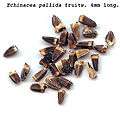Echinacea pallida
Echinacea pallida, the pale purple coneflower,[2] is a species of herbaceous perennial plant in the family Asteraceae. It is sometimes grown in gardens and used for medicinal purposes. Its native range is the central region of the United States.
| Echinacea pallida | |
|---|---|
.jpg) | |
| Scientific classification | |
| Kingdom: | Plantae |
| Clade: | Tracheophytes |
| Clade: | Angiosperms |
| Clade: | Eudicots |
| Clade: | Asterids |
| Order: | Asterales |
| Family: | Asteraceae |
| Genus: | Echinacea |
| Species: | E. pallida |
| Binomial name | |
| Echinacea pallida | |
| Synonyms[1] | |
| |
Description
Echinacea pallida is similar to E. angustifolia, but plants often grow taller, ranging from 1.5 to 2.5 ft (45 to 75 cm) tall, with some growing 3 ft (90 cm) or more tall. Plants normally grow with one unbranched stem in the wild, but often produce multi-stemmed clumps in gardens. They have deep taproots that are spindle shaped, wider in the center and narrowing at the ends. Stems are green or mottled with purple and green. The leaves are elongated lanceolate or linear-lanceolate with three veins. Flower head rays are narrow, linear, elongated, and drooping, ranging from 1 to 3 inches (2.5 to 7.6 cm) long. The flower heads are from 3⁄4 to 3 inches (1.9 to 7.6 cm) wide with pale rose-purple or nearly white ray florets. The flowers have white pollen. Echinacea pallida blooms from May into July.[2] The fruits are cypselae and are tan or bi-colored with angled edges.[2][3]
Distribution
It is found in the Mississippi Valley, the southeastern Great Plains, and the region south of Lake Michigan. Most of the known populations are in the region from southern Wisconsin and Iowa south to Louisiana and eastern Texas, with additional reports (many of them likely from introductions) in the Southeastern United States, New England, New York, Michigan, and Ontario.[4]
Habitat and range
The states of Tennessee and Wisconsin list the species as threatened, mostly due to habitat loss and over-collection of roots, which are made into herbal medicine. The use of Echinacea as a medicinal plant has not been demonstrated to have any positive health effects.[5][6][7][8][9] It is a larval host to the silvery checkerspot[10].
Gallery
- Flowerhead

 Illustration from Britton and Brown 1913
Illustration from Britton and Brown 1913- In cultivation at the Minnesota Landscape Arboretum
References
- "Echinacea pallida". The Global Compositae Checklist (GCC) – via The Plant List.
- Urbatsch, Lowell E.; Neubig, Kurt M.; Cox, Patricia B. (2006). "Echinacea pallida". In Flora of North America Editorial Committee (ed.). Flora of North America North of Mexico (FNA). 21. New York and Oxford – via eFloras.org, Missouri Botanical Garden, St. Louis, MO & Harvard University Herbaria, Cambridge, MA.
- Britton, N., & Brown, A. (1913). An illustrated flora of the Northern United States, Canada from Newfoundland to the parallel of the southern boundary of Virginia, and from the Atlantic Ocean westward to the 102nd meridian. [S.l.]: Scribner. ISBN 0-486-22644-1
- "Echinacea pallida". County-level distribution map from the North American Plant Atlas (NAPA). Biota of North America Program (BONAP). 2014.
- Turner RB, Bauer R, Woelkart K, Hulsey TC, Gangemi JD (July 2005). "An evaluation of Echinacea angustifolia in experimental rhinovirus infections". N. Engl. J. Med. 353 (4): 341–8. doi:10.1056/NEJMoa044441. PMID 16049208.
- Schwarz E, Metzler J, Diedrich JP, Freudenstein J, Bode C, Bode JC (2002). "Oral administration of freshly expressed juice of Echinacea purpurea herbs fail to stimulate the nonspecific immune response in healthy young men: results of a double-blind, placebo-controlled crossover study". J. Immunother. 25 (5): 413–20. doi:10.1097/00002371-200209000-00005. PMID 12218779.
- Barrett BP, Brown RL, Locken K, Maberry R, Bobula JA, D'Alessio D (December 2002). "Treatment of the common cold with unrefined echinacea. A randomized, double-blind, placebo-controlled trial". Ann. Intern. Med. 137 (12): 939–46. doi:10.1001/archinte.137.7.939. PMID 12484708.
- Yale SH, Liu K (June 2004). "Echinacea purpurea therapy for the treatment of the common cold: a randomized, double-blind, placebo-controlled clinical trial". Arch. Intern. Med. 164 (11): 1237–41. doi:10.1001/archinte.164.11.1237. PMID 15197051. Archived from the original on 2012-03-08.
- Echinacea (Echinacea purpurea, Echinacea angustifolia, Echinacea pallida) [NCCIH Herbs at a Glance]
- The Xerces Society (2016), Gardening for Butterflies: How You Can Attract and Protect Beautiful, Beneficial Insects, Timber Press.